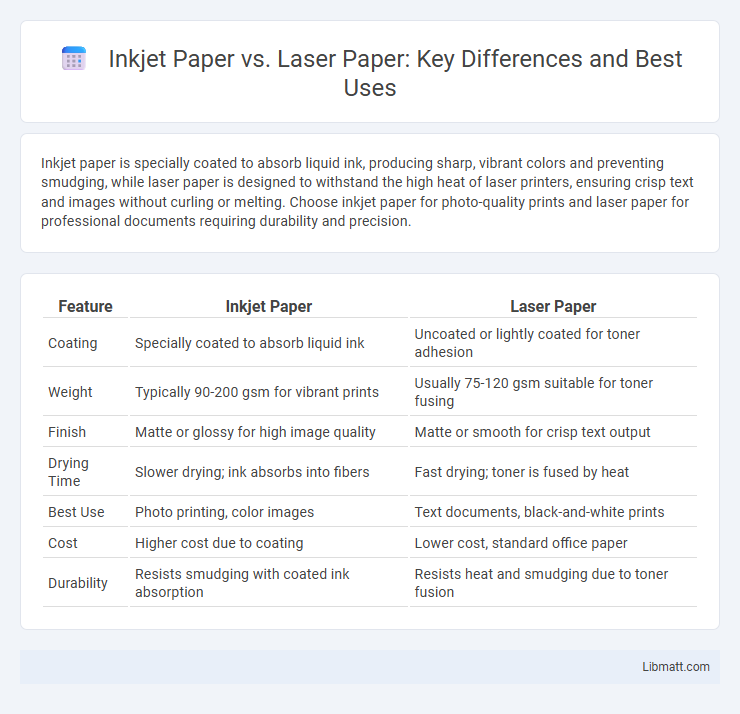Inkjet paper is specially coated to absorb liquid ink, producing sharp, vibrant colors and preventing smudging, while laser paper is designed to withstand the high heat of laser printers, ensuring crisp text and images without curling or melting. Choose inkjet paper for photo-quality prints and laser paper for professional documents requiring durability and precision.
Table of Comparison
| Feature | Inkjet Paper | Laser Paper |
|---|---|---|
| Coating | Specially coated to absorb liquid ink | Uncoated or lightly coated for toner adhesion |
| Weight | Typically 90-200 gsm for vibrant prints | Usually 75-120 gsm suitable for toner fusing |
| Finish | Matte or glossy for high image quality | Matte or smooth for crisp text output |
| Drying Time | Slower drying; ink absorbs into fibers | Fast drying; toner is fused by heat |
| Best Use | Photo printing, color images | Text documents, black-and-white prints |
| Cost | Higher cost due to coating | Lower cost, standard office paper |
| Durability | Resists smudging with coated ink absorption | Resists heat and smudging due to toner fusion |
Introduction to Inkjet Paper vs Laser Paper
Inkjet paper is specially designed with a porous surface to absorb liquid ink droplets, resulting in vibrant colors and sharp details ideal for photo printing. Laser paper features a smooth, heat-resistant coating that withstands the fuser's heat in laser printers, producing crisp text and graphics without smudging. Choosing the right paper enhances the quality of Your prints by matching the paper's properties to the specific printing technology.
Key Differences Between Inkjet and Laser Printing
Inkjet paper is specifically designed with a coated surface to absorb liquid ink, ensuring vibrant and sharp color prints, while laser paper is optimized for dry toner adhesion and heat resistance during the fusing process. Your choice of paper affects print quality and durability; inkjet paper is better for photos and detailed images, whereas laser paper excels with text-heavy documents and faster printing speeds. Understanding these differences helps you select the right paper for your printer, improving output clarity and preventing jams or smudges.
Composition and Coating of Inkjet Paper
Inkjet paper features a specialized coating composed of microporous or swellable polymers designed to quickly absorb and lock in liquid ink, preventing smudging and ensuring sharp, vibrant images. In contrast, laser paper lacks this ink-absorbing layer and is typically made from uncoated or lightly coated fibers to withstand the high heat of laser printing without warping or melting. Understanding the composition and coating of inkjet paper can help you select the right material for optimum print quality and durability.
Characteristics and Design of Laser Paper
Laser paper is specifically engineered to withstand the high heat and pressure of laser printers, featuring a smooth, bright surface that enhances toner adhesion for sharp, clear prints. Its composition often includes synthetic fibers that reduce curl and prevent smudging, ensuring durability and professional-quality document presentation. The paper's weight typically ranges from 20 to 24 pounds, balancing sturdiness and flexibility to optimize feeding reliability in laser printers.
Print Quality Comparison: Inkjet vs Laser Paper
Inkjet paper is specially designed with a coating that absorbs ink, resulting in vibrant colors and sharp details, making it ideal for high-resolution images and photos. Laser paper, on the other hand, has a smooth, heat-resistant surface optimized for toner adhesion, producing crisp text and clear graphics without smudging. Choosing the right paper enhances your print quality by matching ink absorption properties with your printer's technology, ensuring optimal results for your documents or images.
Ink Absorption and Toner Adhesion
Inkjet paper is engineered with a special coating that enhances ink absorption, preventing smudging and ensuring vibrant, sharp images. Laser paper features a smooth, uncoated surface designed for optimal toner adhesion, allowing the heat from laser printers to fuse toner particles effectively onto the paper. Choosing the right paper depends on the printer type to maximize print quality and durability.
Cost Considerations for Inkjet and Laser Paper
Inkjet paper generally costs more per sheet than laser paper due to its specialized coatings designed to absorb liquid ink without smudging, ensuring vibrant, high-quality prints. Laser paper is typically more affordable and optimized for heat and toner adhesion, making it suitable for high-volume printing with sharp text and graphics. Your choice between inkjet and laser paper should consider print volume and quality requirements to balance cost-effectiveness and output precision.
Best Applications for Each Paper Type
Inkjet paper is ideal for vibrant photo printing, detailed graphics, and documents requiring sharp color accuracy due to its specially coated surface that absorbs ink effectively. Laser paper works best for high-volume text documents, business reports, and professional flyers because it withstands high heat and pressure from laser printers without smudging or curling. Choosing the right paper ensures Your prints maintain clarity, durability, and the intended visual impact for each specific application.
Environmental Impact and Sustainability
Inkjet paper is typically thinner and uses less energy in production, contributing to a lower carbon footprint compared to laser paper, which is designed to withstand higher heat and pressure from laser printers. Laser paper often contains coatings or additives that can hinder recycling processes, whereas many inkjet papers are more biodegradable and environmentally friendly. Choosing your printing paper based on these factors supports sustainability by minimizing waste and promoting recyclable materials.
Choosing the Right Paper for Your Printer
Selecting the right paper for your printer enhances print quality and longevity. Inkjet paper features a smooth, highly absorbent coating designed to hold liquid ink without bleeding, making it ideal for vibrant photos and color prints. Laser paper is engineered to withstand high heat from laser printers, with a smoother texture and less absorbency to prevent toner smudging, ensuring your documents remain sharp and crisp.
Inkjet paper vs laser paper Infographic

 libmatt.com
libmatt.com